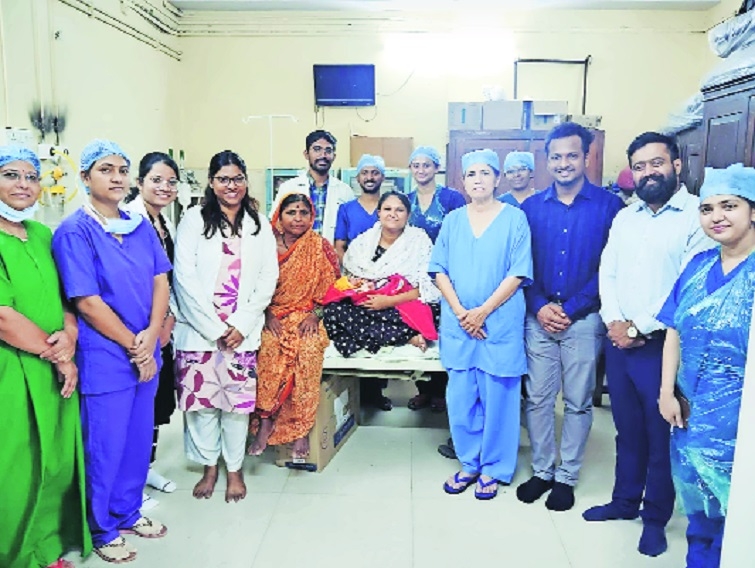IGGMCH doctors save newborn, woman with postpartum haemorrhage
| Date :19-Apr-2025 |

The woman and her newborn with the medical team
of IGGMCH.
Staff Reporter :
The doctors at Indira Gandhi Government Medical College and Hospital (IGGMCH) gave a new lease of life to a woman suffering from postpartum haemorrhage and her newborn. Considering the condition of the pregnant woman who was on a risk of getting postpartum haemorrhage, the Interventional Radiologists kept balloon in the pelvic artery, after which the delivery was performed and then the balloons were inflated to stop the bleeding.
“A 32-year old woman had come to IGGMCH with placenta previa which is nothing but attachment of the placenta at the mouth of uterus from where delivery usually occurs. The patient also had invasion of the uterus because of placenta accreta. So in this patient, there was a a chance of severe postpartum haemorrhage. Considering the risk, we had placed a balloon in both the internal iliac arteries, which supplies blood to uterus,” explained Dr Dinesh Sharma and Dr Arpit Dhakate, Interventional Radiologists at IGGMCH.
This balloon was kept in the artery prior to the delivery of the baby, and after the delivery, the balloons were inflated so that the bleeding could be stopped. Then, placenta and the uterus were removed. Because of this internal iliac placement, the amount of bleeding during the procedure was 500 ml which was very less as compared to routine postpartum haemorrhage which causes around 4 to 5 lakh ml blood loss. This procedure gave a new lease of life to the mother and her newborn. Both baby and mother were discharged in healthy condition after one week.
IGGMCH is pioneering a transformative approach to high-risk pelvic surgeries through the use of bilateral internal iliac artery balloon occlusion, a technique that significantly reduces life-threatening hemorrhage risks. Spearheaded by interventional radiologists Dr Arpit Dhakate and Dr Dinesh Sharma, the procedure involves deploying temporary balloons via catheters to block pelvic blood flow during critical surgical phases.
Guided by real-time imaging, their precision minimises disruption to circulation while creating a ‘bloodless field’ for surgeons. Studies show this method reduces blood loss by up to 40% in complex obstetric cases like placenta accreta, a leading contributor to maternal mortality in India.
Preoperative imaging by Dr Dhakate and Dr Sharma ensured precise balloon placement, while intraoperative teamwork has reduced transfusion needs by 50%. Medical Superintendent Dr Nitin Shende praised the hospital’s culture of unity, saying, “Innovations like this thrive when administration, clinicians, and support staff prioritize patient safety together.” Dr Bhawna Sonawane, Head of Radiology, added, “Our department’s advancements in imaging-guided interventions are key to scaling such life-saving techniques.”
Dean Dr Ravi Chavhan emphasised, “Our balloon occlusion program tackles postpartum hemorrhage head-on, saving mothers and newborns. The hospital also launched training modules for rural healthcare workers to improve perinatal outcomes, aiming to reduce preventable deaths during childbirth.”
Dr Alka Patankar, Unit Incharge of Obstetrics and Gynecology, highlighted the technique’s impact: “In high-risk pregnancies, this procedure is a lifeline. By controlling bleeding, we protect both mother and child.”
The success of this initiative hinges on seamless collaboration between interventional radiologists, surgeons, and anesthesiologists. Looking ahead, IGGMCH plans to expand its hybrid operating rooms and interventional radiology training programs to make this technique accessible across Central India.
Dr Patankar stressed, “Trust between specialties is non-negotiable. Every second counts in emergencies. Supported by visionary leadership and pioneers like Dr Dhakate and Dr Sharma, the hospital aims to set new benchmarks in maternal and surgical safety. As Dr Chavhan noted, “Reducing maternal mortality isn’t just a goal—it’s our duty.” By merging cutting-edge technology with multidisciplinary teamwork, IGGMCH is turning global health aspirations into tangible, life-saving realities for communities in need.”
